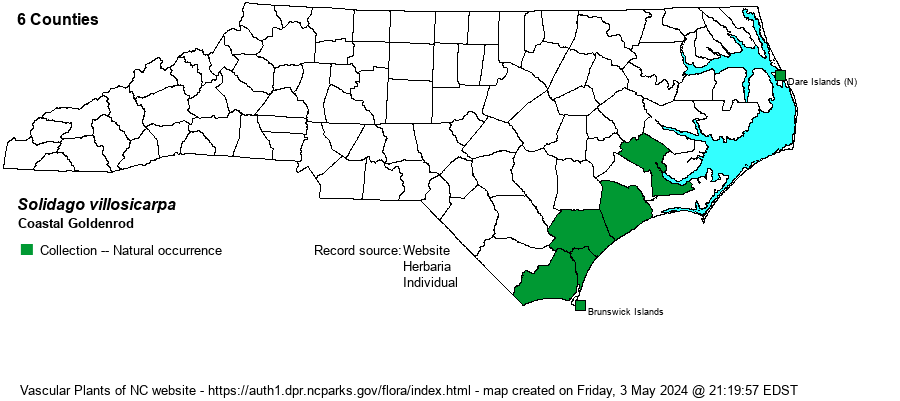| Author | LeBlond | |
| Distribution | Outer Coastal Plain; mostly southern mainland, but disjunct to the northern Outer Banks (Kitty Hawk Woods Preserve). This remarkable goldenrod was first collected in 1949, but not recognized to be a new species until the late 1990s (LeBlond 2000).
As far as is known, endemic to the outer Coastal Plain of NC. | |
| Abundance | Rare to locally common. Scarce in most parts of this coastal region, but the NCNHP database now has several dozen records (though many are sub-populations) that represent about 9 total populations, all extant. Most of these sites are located on Camp Lejeune, in Onslow County. Thus, the website editors suggest a State Rank of S1S2, rather than the NCNHP's rank of S1. The Global Rank of G1 is suggested to be moved to G1S2, if not to G2. Because it is endemic to NC, it is listed as State Threatened. | |
| Habitat | Dry to mesic pine-deciduous forests and woodlands (collectively called maritime evergreen forest), especially along edges and openings of such woodlands. Several populations responded well to the hurricanes of 1996 and 1998, which opened the forest canopy. Its habitats are seemingly not at all rare or specialized, though there may be some preference to growing over underlying marl rock; however, soil pH has apparently not been mentioned as a limiting factor in habitat or range. | |
| Phenology | Flowering and fruiting September-October. | |
| Identification | Plants are relatively tall and robust (2-4 feet), and grow from well-developed basal rosettes of ovate, toothed, wing-stalked, glabrous leaves. Middle to upper stem leaves are smaller, elliptical in shape, and without stalks; however, these stem leaves tend to be quite a bit larger than in many similar goldenrods with large basal leaves. Inflorescences vary from narrowly cylindrical with very short branches to broadly elliptical and with strongly ascending branches. A clinching character is the short, spreading hairs on the seed body. Otherwise, it looks like a robust and leafier version of Cutleaf Goldenrod (S. arguta). When encountering this conspicuous and rather large plant, along a wooded road margin, one wonders how this "new" species went so long without a formal name, other than being called as a robust form of Cutleaf Goldenrod. | |
| Taxonomic Comments | The type specimen was collected from Camp Lejeune, Onslow County.
| |
| Other Common Name(s) | Carolina Maritime Goldenrod, Hairyseed Goldenrod, Glandular Wand Goldenrod (a poor name, as it is not wand-like), Shaggy-fruit Goldenrod | |
| State Rank | S1 [S1S2] | |
| Global Rank | G1 [G1G2] | |
| State Status | T | |
| US Status | | |
| USACE-agcp | | |
| USACE-emp | | |

